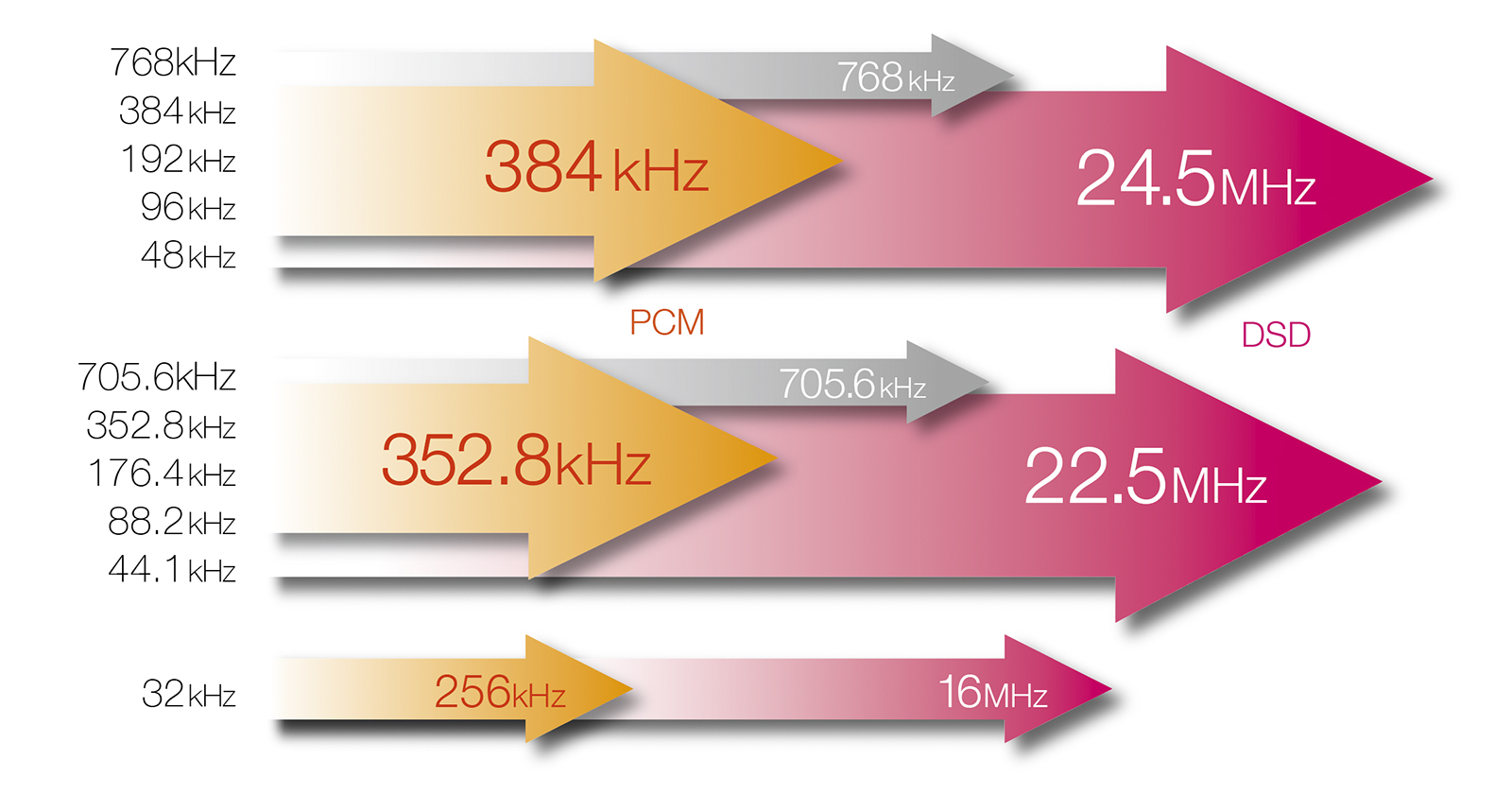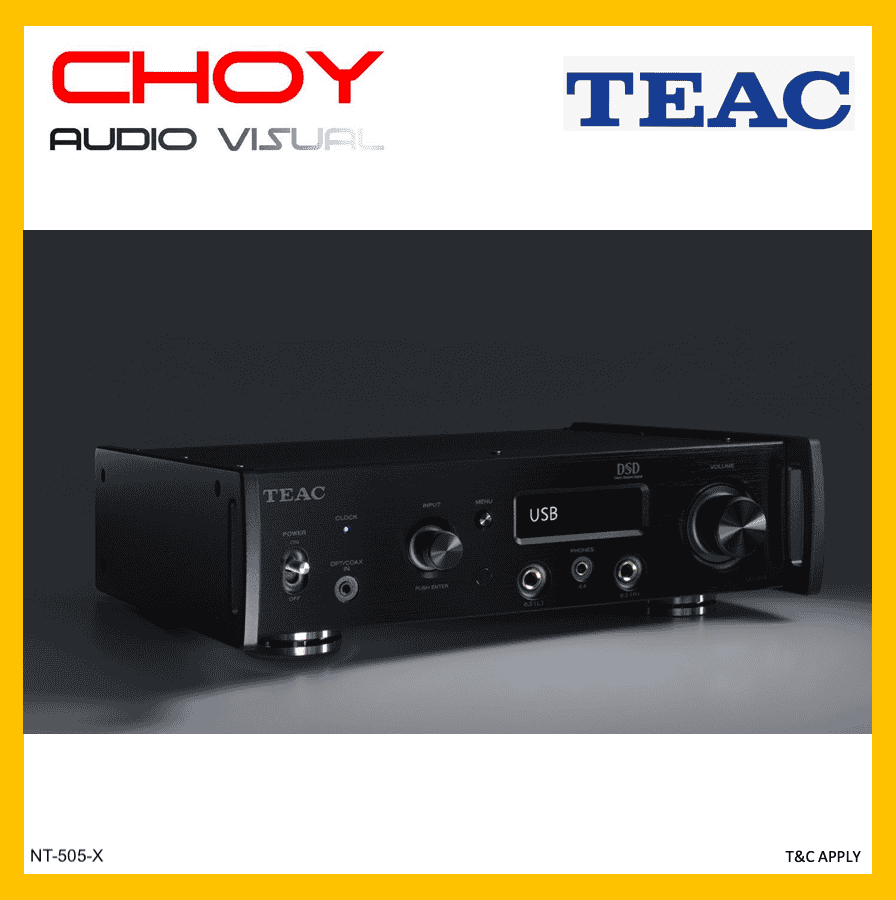Description
The NT-505-X is a class-leading dual monaural USB DAC with versatile network playback capabilities. It successfully incorporates the latest network technologies, along with TEAC’s decades of accumulated audio design experience, in an attractive package with an A4-sized footprint. The dual mono structure processes stereo signals with higher purity, and the D/A converter section uses one ES9038 Q2M (made by ESS Technology) in each of the left and right channels. This model achieves a high signal-to-noise ratio by using each DAC in mono mode. Moreover, when used as a USB DAC, its high specifications enable native playback of 22.5MHz DSD and 768kHz/32bit PCM formats. The Analog section, which is one of the keys to sound quality, includes four TEAC-HCLD2 buffer amp circuits that allow different drive modes, – fully-balanced drive for balanced output, and parallel drive mode for unbalanced output – to achieve enhanced acoustic expression.
On the network audio side, the NT-505-X supports high-quality music subscription services, namely TIDAL, Qobuz and Roon Ready*. There’s also a built-in MQA decoder, and you will enjoy unlimited music content on the Internet thanks to its high-quality digital and Analog processing technologies.
Furthermore, you can also enjoy wireless playback from smart devices with high audio quality thanks to the high performance specifications of the DAC.
A capable network player with MQA master quality decode supporting music subscription services on Internet such as Qubuz and Roon Ready, as well as connections with music servers, USB flash drives, and smartphones.
ESS Technology ES9038 Q2M high-performance DAC supports resolutions up to 22.5MHz DSD and 768kHz/32bit PCM
We have employed one DAC chip, a crucial component for digital audio, in each of the stereo channels. The ESS Technology ES9038Q2M SABRE32 Reference DAC we use has a strong reputation in the high-end audio market. Using 32-bit HyperStream® II DAC architecture and Time Domain Jitter Eliminator (both of which are ESS original technologies), an outstanding dynamic range is realized, and linearity is increased in the D/A conversion. As a result, clear and accurate audio playback with superior dynamic characteristics has been made possible.
![]()
Dual monaural circuit design and fully-balanced design
A dual monaural circuit configuration is used throughout, from the power supply (including power transformers), to the D/A converters in the digital section and the Analog output stage. From the high-performance D/A converters to the massive toroidal-core power transformers, each element is configured for single channel processing. This prevents mutual interference effects while reproducing a rich acoustic expressiveness. In addition, the Analog audio signals of both the left and right channels are processed in full balanced mode soon after the D/A converters all the way to the output terminal, contributing to an improved S/N ratio and extended dynamic range.
This allows the fantastic sense of air that Hi-Res formats possess to be processed and conveyed without any losses.
Support for popular and convenient network functions, including OpenHome and Roon Ready
Common control apps that support OpenHome can be used with the NT-505-X, which also supports this platform. Moreover, playlists on the NT-505-X can be managed using TEAC HR Streamer and other control apps that support OpenHome. Gapless playback is also supported.
With support for Roon Ready, functions provided by RAAT (Roon Advanced Audio Transport), including high-quality audio playback, easy and convenient operation using apps, and multi-room synchronized playback, can be used without limits.
* Support for Roon Ready will be added in a firmware update made available after product release.
![]()
Supports Spotify Connect, TIDAL, Qobuz, and TuneIn
By connecting the unit to a home network using a LAN cable, music files saved on NAS music servers and computers can be accessed and played back. In addition, this unit also supports the Spotify, TIDAL, and Qobuz subscription Internet music streaming services. These enable listening to tens of millions of lossless CD-quality (44.1kHz/16bit) music tracks.
![]()
MQA decoder for master quality streaming
In order to achieve an Analog waveform closer to the original signal, the NT-505-X supports MQA decoding while also supporting high sampling rate Hi-Res formats like DSD512 (22.5MHz) and PCM 32bit/768kHz. The MQA decoder is a totally new technology that controls Analog waveforms with excellent precision (as fine as 5 microseconds) and it reproduces sound in a manner that is perceived to be as close as possible to the original (to human hearing).
Furthermore, a high-efficiency compression algorithm makes huge Hi-Res audio files compact in size, so you will be able to enjoy Hi-Res audio sources regardless of the speed of your Internet connection
![]()
High-quality wireless audio streaming via Bluetooth®
In addition to conventional SBC and AAC codecs, the NT-505-X also supports LDAC™ (24bit/96kHz Hi-Res audio transmission), and Qualcomm® aptX™ HD, a codec that uses 24bit/48kHz format transmission. These allow you to playback playlists on your smartphone and tablet wirelessly.
![]()
Hi-Res audio playback from USB flash drive
The USB port on the front panel allows you to playback Hi-Res audio formats including DSD128 (5.6MHz) and PCM 24bit/192kHz downloaded from Internet or digitally recorded with the SD-500HR.
Dual onboard clocks for 44.1k and 48kHz, and an external clock input
Instead of referencing to an unstable and noisy PC clock during USB audio playback, a more accurate and on-board clock is generated by a high-precision, low phase-noise, audio-grade crystal oscillator for USB asynchronous transfer mode. The NT-505-X accommodates two on-board clocks exclusively for 44.1kHz and 48kHz sampling frequencies and applies the appropriate one to incoming digital signals – those that are multiples of 44.1k or 48k – to reproduce identical sound to the original by eliminating jitter effects on the audio signal.
In addition, an external 10MHz clock input is also provided, to synchronize with an even higher-precision master clock generator, such as the TEAC CG-10M/CG-10M-A, for yet further upgraded audio playback with excellent sound quality.
![]()
Up-conversion up to 384kHz/32bit PCM and 24.5MHz DSD
Employing RDOT-NEO (Refined Digital Output Technology NEO), a fluency algorithm that renders digital audio signals smoothly, the NT-505-X up-converts PCM digital signals up to 384kHz/32bit PCM and 24.5MHz DSD. With the up-conversion function activated, you will hear an improvement in quality, even with music that you are familiar with.

“Bulk Pet” USB transfer technology for enhanced audio quality
When transferring large volumes of digital data for Hi-Res audio sources through USB cables using conventional isochronous transfer mode, large variations can occur in the processing loads of the sending computer and the receiving USB DAC.
This can cause sound to drop out and other problems to occur. However, with our new USB transmission technology – dubbed “Bulk Pet” – a fixed amount of data is transmitted constantly, levelling out the processing burden on both devices and contributing to stable data transmission.
Changing the processing burden on the computer directly affects audio quality so users can select the setting they prefer (from four transmission modes).。

7 types of PCM digital filters
There are seven types of PCM digital filters, allowing you to apply the filter that best matches the file format or type of music you’re listening to. The filter can be changed at the touch of a button on the remote control, allowing you to enjoy the different sonic nuances of each filter.
Dual high-capacity toroidal-core power transformers
The dual monaural theme continues. Two over-sized high-capacity toroidal-core power transformers are employed in the NT-505-X, supplying stable, individual current sources for each of the left and right channels. This means neither channel will be affected by changes in the power consumption of the other during digital processing.












